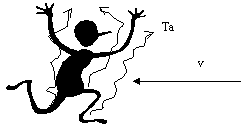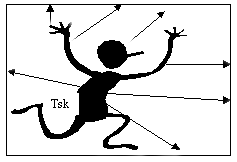The underlying processes
This section looks at the basic methodologies which scientists use to evaluate thermal comfort and in particular the basic processes of heat exchange.
A detailed description of the physical processes underlying thermal comfort is not appropriate, but it is useful to briefly touch on the main points. Don McIntyre’s excellent book Indoor Climate (1980) is a good starting point for those who want to know more.
Physiology: metabolic heat and the control of deep body temperature
We produce energy by "burning" food to produce the energy we need to live. Most of this energy takes the form of heat. The body produces this `metabolic heat’ all the time: more is produced when we are active and the more active we are the more heat is produced. Heat is transported around the body by the blood. The organs of the body, and particularly the brain, must be stay at about 37oC. The body has mechanisms for controlling the deep body (or core) temperature. If our brain temperature exceeds acceptable limits, the body reacts to restore heat balance.
A drop in core temperature causes vaso-constriction: blood circulation to the surface of the body is reduced, and the temperature of the skin drops cutting the heat loss. A further drop in core temperature leads to increased tension in the muscles and then shivering to increase metabolic heat. A rise in core temperature causes vaso-dilation: the blood supply to the periphery is increased, increasing skin temperature and heat loss to the surroundings. A further increase causes sweating to increase heat loss by evaporation.
Psychophysics: how we feel about the environment.
The physiological actions described above are augmented by the thermal sense in the skin. This adds information about the skin temperature, warning of conditions that might pose a danger. There are two types of skin temperature sensors, one concerned mostly with heat and the other with cold. Our impression of the warmth or cold of our environment arises in part from the skin sensors. It is integrated with the core temperature so that the sensation may be pleasing if the overall effect is likely to restore thermal equilibrium and unpleasant if it works against it. Thus a cold skin sensation will be pleasant when the body is overheated, unpleasant if the core is already cold. The sensation from any particular part of the body will depend on time, location and clothing as well as the temperature of the surroundings.
Psychophysics is the study of the relation between the sensations we experience and the stimuli we receive from the physical world. The relationship between thermal sensation and the thermal environment is hard to model. Psychophysical experiments have concentrated on more defined relationships such as the warmth and cold of surfaces when they are touched. Nevertheless the thinking behind field studies of thermal comfort has been to relate thermal sensation to the stimuli of the thermal environment.
The section on conducting comfort surveys looks at how we try to assign numbers to our thermal sensation (the comfort vote). However an ability to say how we feel does not imply a one-to-one relationship between thermal comfort and the physical conditions which cause it. The pleasure given by a thermal stimulus depends, not only on the physiological conditions at the time the stimulus is received but also on the social and other conditions prevailing and on the recent thermal experiences of the person concerned. So a particular stimulus can give rise to a range of sensations. We can’t say that a set of conditions will give rise to a particular sensation, only that there is a probability that it will.
Physics: the avenues of heat loss.
To the physicist the human being is a heated body with variable surface characteristics, losing heat to the environment through three principal pathways, Convection , radiation and evaporation. In certain circumstances significant amounts of heat are also lost by conduction to surfaces we are in contact with, but this is normally a secondary path of heat loss.
Convection
We are surrounded by air. When the temperature of the air is lower that skin temperature then we will lose heat from the body by convection. When air temperature is above skin temperature we will gain heat. In cool still conditions air heated by the body will become buoyant when the body heats it. It will then rise up and form a `plume' above the head and then disperse. Any movement of the air will add to the cooling by helping to strip the warmed air from the body at a greater rate, effectively cooling the air in contact with the body. Air movement is counted relative to the body surface so, for instance walking will add to the effective air movement. Turbulence in the air stream can also have an effect helping to increase the cooling effect of air movement.
 Picture demonstrating Convection
Picture demonstrating Convection
These effects occur whether or not the body is clothed. Where clothing is worn the cooling effect of convection occurs at the clothing surface so instead of the skin temperature it is the temperature of the surface of the clothes which effects the rate of loss of heat. By insulating the skin the rate of heat loss is reduced. Air movement can also have some impact on its effectiveness of clothing as an insulator: a permeable material allowing the cool air to penetrate further and reduce the garment's effectiveness.
Where the air in contact with the body is hotter than skin temperature all these effects act in the opposite direction to heat the body.
In summary: the cooling (or heating) effect of the air depends on the difference between air temperature and skin (or clothing surface) temperature and on the air movement. The effect of air movement is generally considered to be roughly proportional to the square root of the air velocity. These can be represented mathematically
Radiation
All bodies emit heat at their surface at a rate which is proportional to the fourth power of their absolute temperature (absolute temperature is equal to the celsius temperature plus 273). At the same time surrounding surfaces are radiating to the body in a similar fashion. So the looses heat if the surroundings are colder and gains heat if they are hotter. If the surroundings were all at one temperature the situation would be relatively simple. But of course they are not, in any real situation there will be cold windows or hot ceilings, radiators and even the sun. There is not space here to go too far into the details of radiant energy exchange.
 Ts
Ts |
Radiation diagram |
The full picture integrates the effect of every part of the surrounding surfaces with every part of the body. The usual simplification is to talk in terms of the ‘mean radiant temperature’ (Tr). This is the temperature of a sphere which would exchange no net radiation with the surroundings. The notion of the mean radiant temperature is very useful. It can be used to assess the cooling or heating effect of the environment.
In a real situation the radiant temperature will vary from point to point in a room and the size of the human body means that it will even vary from point to point on the body. In general a rough estimate of radiant temperature such as the average temperature of the room surfaces is all that can be achieved. The effect of any large surface with a different temperature needs to be taken into account especially as people notice radiant asymmetry (often interpreting it as a `draught' in the case of a cold surface).
Their is only a relatively small temperature range in most human buildings. The fourth power law for radiant heat exchange can therefore be approximated so that the radiant heat loss is roughly proportional to the temperature difference between the clothed surface and the radiant temperature. mathematically
Evaporation
When water evaporates it extracts a quantity of heat (the latent heat of evaporation) from its surroundings. The evaporation of water from the surface of the skin means much of the latent heat is extracted from the skin and cools it. This cooling effect is very powerful, (the evaporation of 1g/minute is equivalent to 41W) and is used by the body for cooling when we sweat. It is not the sweating that cools us but the evaporation of sweat from the skin.
After the sweat has been evaporated it must move away from the skin if it is to be successful, in order that more evaporation can occur. The driving force for evaporation is the gradient of the water vapour pressure near the skin surface. The water vapour pressure is that part of the total pressure of the air that is caused by the molecules of water in it. The hotter the air, the more water it is capable of carrying. The maximum driving force is the difference between the vapour pressure at skin temperature and the vapour pressure in the air as a whole.

Evaporation diagram…
The heat lost by evaporation from the skin is usually caused by the amount of sweat produced and not the maximum that can be evaporated (this would require the body to be totally wet with sweat). So the sweat glands and not the physical conditions usually govern the heat loss by evaporation.. Air movement tends to increase evaporation in much the same way as it increases convection. So the water vapour pressure in the atmosphere and the square root of the air velocity drives the possible heat loss by evaporation. mathematically
Other avenues of heat loss
There is also some residual heat loss by evaporation even when sweating is not necessary. This is due to evaporation from the surface of the lungs during breathing and through the evaporation of insensible moisture on the skin. The rate of heat loss from the lungs depends on metabolic rate (because the rate of breathing depends on metabolic rate) and the difference between the saturated water vapour pressure at core temperature (in effect almost a constant) and pa, the loss from the skin depends on (pssk-pa) in much the same way as sweating. These contributions to heat loss can be a substantial part of the whole, (quoted as 20-30% for a sedentary person in thermal comfort) - particularly so in cool or dry conditions. mathematically
Clothing plays a major role in enabling man to survive outside the tropics. Clothing it is of particular importance to the adaptive model of thermal comfort. In the physical model of the heat transfer the clothing is assumed to be a uniform layer of insulation between the body and the environment with a single surface temperature (Tcl) which we have used in some of the equations above. Quite clearly this is an approximate treatment, since the clothing is anything but uniform. The face in particular is generally unprotected and the actual clothing insulation varies from place to place on the body according to the nature of the clothing ensemble. In practice, however, the assumption appears to work quite well, and the overall insulation of the clothing can be expressed as the sum of the contributions from the individual items of clothing being worn, as if they were each spread over the whole of the body surface. In this context the layers of air trapped between multiple layers of clothing and between the clothing and the skin are counted as part of the ensemble.
 Clothing
illustration
Clothing
illustration
The insulation of the clothing is generally expressed in `clo units' where 1 clo = 0.155 m2.K/W. Tables of clo values for typical ensembles , and for individual clothing items are given in elsewhere. There is always a big problem with such descriptive tables: they are culturally defined and a thick suit in one climate might be counted rather thin in another. mathematically
In addition to acting as insulation against the transfer of dry heat, the clothing has an effect on the heat loss by evaporation. It affects evaporative cooling by introducing extra resistance to water vapour depending on its permeability to moisture and it can absorb excess moisture next to the skin. The absorbed moisture is then evaporated from the clothing and not from the skin, so it is not so effective in cooling the skin.
The way clothing works is often more complex than suggested. In some hot dry climates, for instance, the inhabitants wear loose, multiple layered clothing to keep the high environmental temperatures away from the skin, whilst allowing heat loss by evaporation when dry air is pumped through the clothing as the body moves.
Another complication in dealing with clothing is that its function is not purely thermal. Our social as well as our thermal needs determine the way we clothe ourselves. Wearing a jacket open or closed can make a significant difference to its thermal characteristics. Chair upholstery may add as much as 0.2-0.4clo, to the standard methods for estimating clothing insulation. The need to specify the value of the clothing insulation and permeability is a source of considerable uncertainty in the heat balance model of human heat exchange.
Behaviour
Behaviour plays an important role in our thermal interaction with the environment. All the approaches to our thermal interactions with the environment listed above assume that the environment acts upon us and that we react to it in a passive way. In fact we interact strongly with the environment. Thermal interactions take a number of forms:
* clothing changes
* changes of posture and metabolic rate
* making use of thermal controls to change the current environment.
* movement between different thermal environments
All of these interactions are under conscious control and augment the unconscious physiological reactions which have been referred to.
Time also plays a part in this interaction. There are four typical time-periods for these effects:
* Instantaneous (or anticipatory) - the change of clothing in anticipation of a thermal change such as putting on a coat before going out.
* Within-day - the clothing changes, changes of posture or environmental adjustments we use to cope with unexpected environments within a particular day.
* Day-to-day - we learn from one day to the next how to cope with changing conditions such as the weather.
* Longer term - seasonal changes in clothing, use of buildings, activities learnt over a longer period.
In order to fully describe people's thermal experience we need to take account of all these changes. The total picture should be consistent with the findings drawn from physics and physiology, but it will change with climate, place and time in a dynamic and interactive way.
Mathematical representation of heat flow equations:
Put mathematically (McIntyre 1980)
C = hc fceff (Tcl - Ta) W/m2 (3.1.1)
Where C is the convective heat loss per square metre of body surface
Tcl is the clothing surface temperature (oC)
Ta is the air temperature (oC)
hc is the convective transfer coefficient. in W/m2K
fceff is the effective convective area factor (usually less than one because some parts of the body (eg when the arms are crossed) are in contact with each other rather than with the air)
hc is itself dependent on Tcl - Ta, and the air velocity (v), but the dependence on temperature is small so that hc is generally taken to be given by:
hc = 4W/m2K for v< 0.2m/s (3.1.2)
hc = 8.3 v0.5 W/m2K for v> 0.2m/s (3.1.3)
the constant value at low air speeds reflects air currents from natural convection
R = ehrfclfeff(Tcl - Tr) W/m2 3.2.1
where e is the emissivity of the clothed/skin surface (generally very close to 1)
hr is the linear radiation transfer coefficient (W/m2K)
fcl is the effective clothed area (greater than one because the volume of a clothed body is greater than a nude one)
freff is the effective radiation area factor (less than one because in some parts - eg under the arms - the body radiates to itself rather than to the environment)
Tcl is the clothing surface temperature (deg C)
Tr is the mean radiant temperature (deg C).
as a first approximation:
fcl = 1 + 0.15 Iclo 3.2.2
where Iclo is the clothing insulation (see section 7 for tables)
freff = 0.7 when seated, 0.72 when standing (Fanger) 3.2.3
hr = 4.6 (1 + 0.01Tr) W/m2K 3.2.4
So the evaporative heat loss is given by:
E = whe(pssk - pa) 3.3.1
where he is the evaporative heat transfer coefficient
Pssk the saturated water vapour pressure at skin temperature (mb)
Pa the water vapour pressure of the air (mb)
w is the `skin wettedness' a factor which relates the actual sweating heat loss to the maximum possible
Note: whilst skin wettedness is a factor in the mathematical equation, it will only affect the thermal balance when it implies that the body is having trouble evaporating all the sweat it is producing (though discomfort caused by sweaty skin may also be a problem).
he = 13.7v0.5 W/m2mb (= 1.65hc) 3.3.2
The insensible loss has been determined empirically as:
Eis = 4 + 0.12 (pssk-pa) W/m2 3.4.1
The respiratory heat loss has two components, latent due to evaporation and dry due to convective heat transfer in the lungs:
Eres = 0.0017M(59 - pa) W/m2 3.4.2
Cres = 0.0014M(34-Ta) W/m2 3.4.3
M is the metabolic rate in W/m2
K = R + C = (Tsk - Tcl)/(0.155Iclo) W/m2 3.5.1
where K is the conducted heat through the clothing (equal to the radiative (R) and convective (C) losses from the clothing surface)
Iclo is the clothing insulation in clo units
Emax = fpclhc(pssk-pa) W/m2 3.5.2
where Emax is the maximum evaporation from the clothed body surface (before this value the evaporation is physiologically and not physically determined)
fpcl is the permeability efficiency factor of the clothing ensemble
fpcl = 1/(1 + 0.143hcIclo) 3.5.3